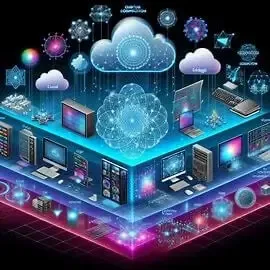Search This Blog

Explore Cloud Computing Insights by Dr. Angajala Srinivasa Rao — your trusted destination for comprehensive articles, tutorials, and trends in Cloud Computing, Architectures, Virtualization, IaaS, PaaS, SaaS, Fog & Edge Computing, Cloud Security, and emerging technologies. Get practical guides, real-world examples, and career tips to help students, professionals, and technology enthusiasts stay ahead in the cloud era."
Cloud Computing: Revolutionize Your Business with Efficiency and Flexibility
Are you tired of dealing with the limitations of traditional IT infrastructure? Say goodbye to hardware hassles and embrace the power of cloud computing. With cloud computing, you can take your business to new heights with scalability, efficiency, and flexibility.
- Scalability: Adjust your resources as your needs change.
- Efficiency: Focus on your business, not system maintenance.
- Flexibility: Access your data and apps from anywhere, any time.
- Security: Benefit from robust cloud data protection.
- Cost Savings: Pay only for what you use.
Cloud computing simplifies IT and boosts growth. Let's harness its power.
Featured Post
- Get link
- X
- Other Apps
Study of Computing
Understanding the Computing Paradigm
From Sequential to Cloud Computing
Introduction
The computing paradigm has evolved significantly over the decades, shaping the way we solve problems, process data, and build applications. From the earliest sequential systems to today's powerful cloud and quantum computing, this article explores the key computing paradigms that have defined the digital world.
Key Computing Paradigms
- Sequential Computing: Traditional single-task computing, executing instructions one after another.
- Parallel Computing: Simultaneous execution of multiple tasks using multiple processors, enhancing performance in data-intensive tasks.
- Distributed Computing: Collaborative processing across multiple interconnected computers or nodes, enabling scalability and fault tolerance.
- Client-Server Computing: Model where clients request services from centralized servers, forming the basis for internet applications.
- Grid Computing: Coordination of geographically distributed and heterogeneous computing resources for large-scale tasks.
- Cloud Computing: Delivery of computing services over the internet, offering scalability, flexibility, and on-demand resources.
- Bio Computing: Leveraging biological systems like DNA and proteins to perform complex computations.
- Mobile Computing: Accessing computing resources on the go using mobile devices and wireless networks.
- Quantum Computing: Utilizing quantum bits (qubits) for computation, promising revolutionary performance in complex problem-solving.
- Edge Computing: Processing data closer to the source to reduce latency and bandwidth usage.
- Optical and Nano Computing: Exploring new frontiers in computing using light (photons) and nanoscale technologies.
- Network Computing: Leveraging interconnected devices and resources over networks for collaborative work and services.
- Fog Computing: Extending edge computing by adding an additional layer between the edge and the cloud for better efficiency and security.
Conclusion
The journey of computing paradigms illustrates the continuous quest for higher performance, efficiency, scalability, and intelligence. Understanding these paradigms equips learners and professionals to adapt to new technologies and innovate in the evolving digital landscape.

👉 Dive deeper into cloud computing architecture and infrastructure:
Explore Cloud Computing Architecture
✅ SHARE
- Get link
- X
- Other Apps
Popular Posts

Cloud Computing Definition
- Get link
- X
- Other Apps

Cloud Computing Topics
- Get link
- X
- Other Apps
Comments
Post a Comment